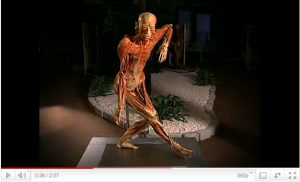![By Paul Stevenson (http://www.flickr.com/photos/pss/2252443224/) [CC-BY-2.0 (www.creativecommons.org/licenses/by/2.0)], via Wikimedia Commons](http://upload.wikimedia.org/wikipedia/commons/0/0e/Koerperwelten02.jpg)
Dr. Gunther von Hagens (1945- ) revolutionized methods for dissecting and studying the human body after a person is deceased. When he began this work, human bodies were being dissected for scientific research, and they were often preserved by being cut and hung in sections in transparent blocks of plastic. These plastic blocks lengthened the time the bodies could be studied before they began decomposing. However this method did not allow scientists the opportunity to touch and handle the bodies. It also failed to reveal how bodies appear while in motion, which became his ultimate goal.
After acknowledging the problem and observing the current methods for body preservation and dissection available to him, Dr. von Hagens began asking questions to develop better techniques for studying human anatomy cadavers.
Dr. von Hagens began to experiment with a procedure later named plastination. By asking himself how plastic blocks preserved the bodies, he came up with an idea to inject plastic directly into the cells of a cadaver. This procedure immediately stopped the decomposition, making the cells rigid and causing them to hold their permanent form. This process also allowed him to directly handle the bodies.
Over the past few decades, Dr. von Hagens has fine-tuned the plastination process, and more than 400 institutions in 40 countries have adopted the method for medical instruction. He advocates his preservation techniques all over the world and continues to champion its practicality in the face of religious and philosphical opposition.
He created the famous BODY WORLDS exhibit which has traveled across the globe, showcasing bodies treated with this techniques. These figures illustrate human anatomy in motion including, dancing, ski jumping, ice-skating and skateboarding. Although plastination is a controversial procedure and relies on people willingly donating their bodies for dissection and public exhibition upon death, it has revolutionized the way we view and understand the human body.
How can you be more innovative? The SOLVE FOR TOMORROW competition just posted the the top 10 finalists for 2011. Students were asked to answer, “How can science or math help the environment in your community?” and answered back with 2 minute videos proposing inventions from cutting back on pollution using vegetable-powered buses to saving the salmon with solar power. Click here to watch and vote.
This profile was taken from LifeBound’s CRITICAL AND CREATIVE THINKING FOR TEENAGERS. Want to learn about more great thinkers and creators from history? Click here.










